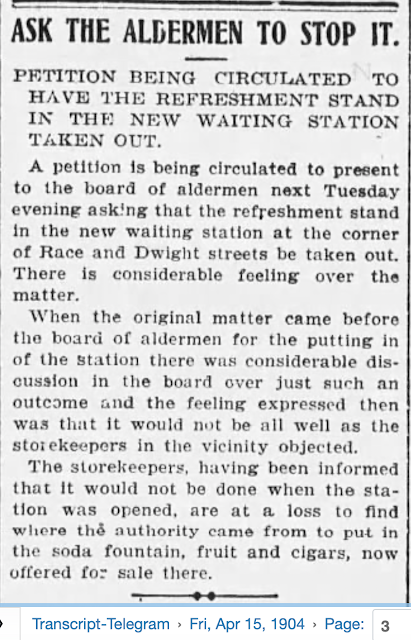One of the many fascinating buildings in Holyoke was the 600-square-foot Waiting Station, constructed over the Second Level Canal water at Race and Appleton Sts. The Waiting Station was undoubtedly unique. Conceived in the early 20th century as a trolley stop for the Holyoke Street Railway, a portion of the building's foundation jutted into the canal.
Much of the foundation, brickwork, and flooring were completed in 1903. To my surprise, the building had a basement that rose several feet above the canal. The basement walls were cemented while the canal was drained for seasonal maintenance. A covered wooden porch facing the canal sheltered those awaiting the trolley.
Holyoke Water Power (HWP) retained ownership and control over the land and building while leasing the station to the Holyoke Street Railway (HSR). A key provision in the lease was that the building would be razed if a suitable renter did not come forward once the lease had elapsed.
The Waiting Station officially opened on April 13, 1904. It was equipped with running water and a refreshment stand selling beverages, fruits, and cigars. The station also had folding chairs for patron comfort and large windows that allowed patrons to see the oncoming trolley cars. It was built with a men's and women's room.
Several shopkeepers have operated the station throughout its history. Its journey had been challenging, including numerous reported after-hours robberies.
By the 1930s, a half-dozen stools, a counter, and a grill were added.
The Waiting Station continued operating into 1987, long after the last streetcar traversed the city. Thereafter, it became a bus stop. The HSR, however, wound down its operations in 1988, signaling the end of its $1 per year lease with HWP.
Efforts were made to save the building by finding a use for it and a tenant. However, a news account below indicated that HWP was not eager to pursue this unless it was for the benefit of public service. The Waiting Station met its demise and was razed in early 1991, 87 years after its construction.
Source of news articles: Newspapers.com (paid subscription): Citations Holyoke (Massachusetts) Transcript-Telegram; Publication dates are shown.
Source: Public Records, Registry of Deeds, Hampden County, Springfield Mass.
circa 1970s
circa 1970s
circa 1988































































